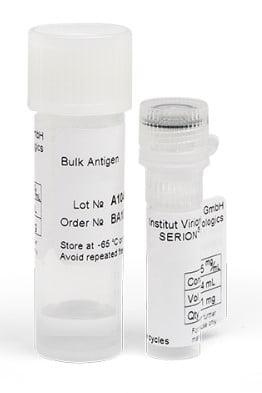| Weight | 1 lbs |
|---|---|
| Dimensions | 9 × 5 × 2 in |
| host | mouse |
| isotype | IgG1 |
| clonality | monoclonal |
| concentration | 1 mg/mL |
| applications | ICC/IF, WB |
| reactivity | Measles Nucleoprotein |
| available sizes | 100 µg |
mouse anti-Measles Nucleoprotein monoclonal antibody (2F3) 5089
$520.00
Antibody summary
- Mouse monoclonal to Measles Nucleoprotein
- Suitable for: WB,ICC,ELISA
- Isotype: IgG1
- 100 µg
mouse anti-Measles Nucleoprotein monoclonal antibody (2F3) 5089
| antibody |
|---|
| Tested applications WB,ICC/IF,ELISA |
| Recommended dilutions ELISA: use at 0.1-1.0ug/ml Immunoblotting: User should use at 1-5ug/ml. A band of ~60kDa is detected Immunocytochemistry: use at 2- 10ug/ml on virus-infected cells. These are recommended concentrations. End user should determine optimal concentrations for the |
| Immunogen Recombinant Measles virus nucleoprotein. |
| Size and concentration 100µg and |
| Form lyophilized |
| Storage Instructions This product is stable for at least one (1) year at -20°C to -70°C. Reconstituted product should be stored in appropriate aliquots to avoid repeated freeze-thaw cycles. |
| Storage buffer Lyophilized, 0.1M Tris, 0.1M glycine, 2% sucrose |
| Purity protein affinity purification |
| Clonality monoclonal |
| Isotype IgG1 |
| Compatible secondaries goat anti-mouse IgG, H&L chain specific, peroxidase conjugated polyclonal antibody 5486 goat anti-mouse IgG, H&L chain specific, biotin conjugated, Conjugate polyclonal antibody 2685 goat anti-mouse IgG, H&L chain specific, FITC conjugated polyclonal antibody 7854 goat anti-mouse IgG, H&L chain specific, peroxidase conjugated polyclonal antibody, crossabsorbed 1706 goat anti-mouse IgG, H&L chain specific, biotin conjugated polyclonal antibody, crossabsorbed 1716 goat anti-mouse IgG, H&L chain specific, FITC conjugated polyclonal antibody, crossabsorbed 1721 |
| Isotype control Mouse monocolonal IgG1 - Isotype Control |
| target relevance |
|---|
| Protein names demerged |
Data
| No results found |
Publications
| pmid | title | authors | citation |
|---|---|---|---|
| We haven't added any publications to our database yet. | |||
Protocols
| relevant to this product |
|---|
| Western blot IHC ICC |
Documents
| # | SDS | Certificate | |
|---|---|---|---|
| Please enter your product and batch number here to retrieve product datasheet, SDS, and QC information. | |||
Only logged in customers who have purchased this product may leave a review.








Reviews
There are no reviews yet.